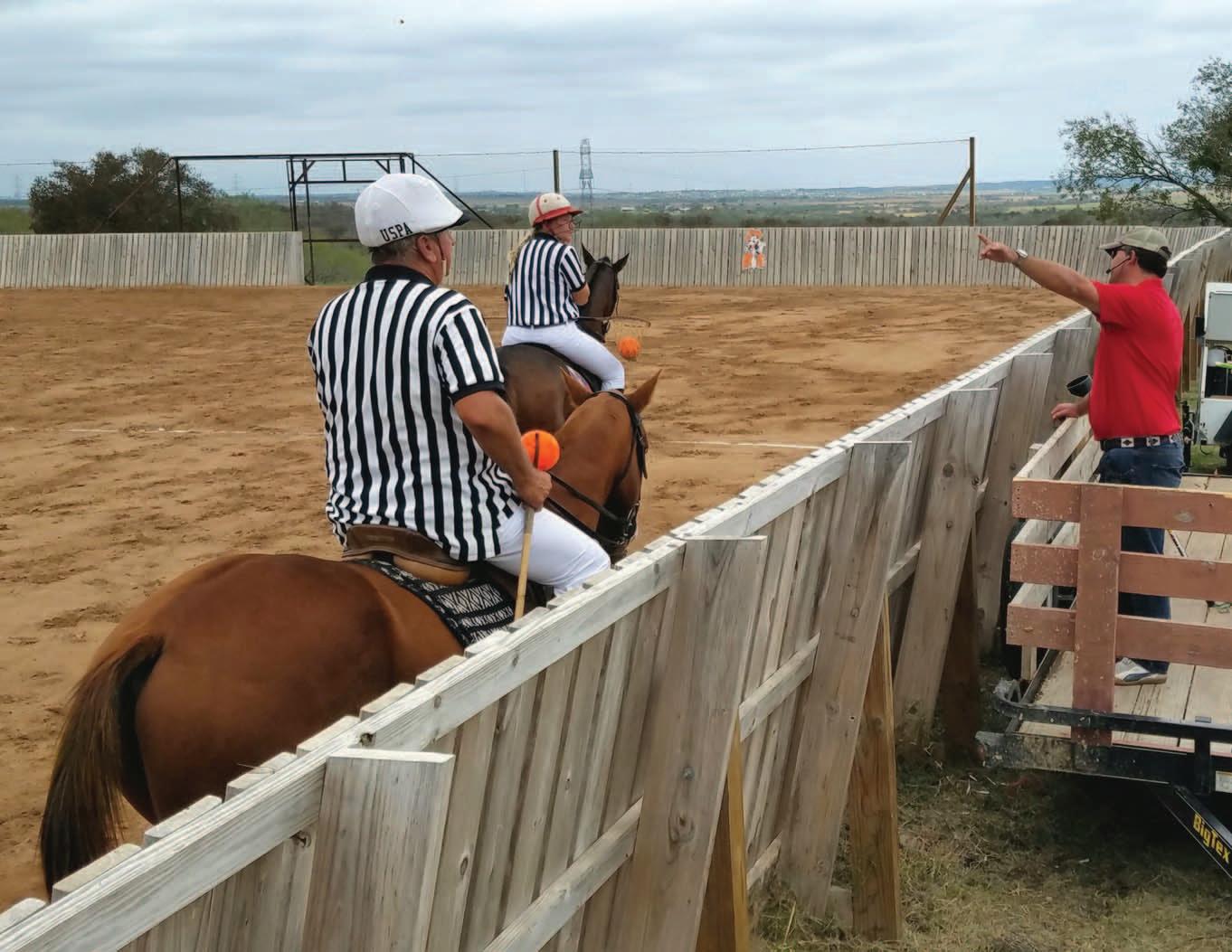
5 minute read
Ask an Umpire
Umpire revolution
Arena rules and officiating has improved
By Bradley Biddle
The USPA holds numerous training tournaments for umpires so everyone is on the same page. Bradley Biddle instructed umpires at a tournament in Texas a few years ago.
Arena Polo has changed in a lot of ways over the past few years. The implementation of new rules, that are in the 2020 Blue Book and have been used as tournament conditions the last few years, has brought a more open style to the game and changed the umpiring, making for a better, open game.
I field a lot of questions in regards to the arena rules. I have listed the most asked questions and explain the answers below:

What are the main fouls you see in arena polo, and do they differ in the lower and higher levels of the sport?
The fouls we see are mainly tight-quarter fouls–reaching (Rule 15b) and blocking the right of way (Rule 12). The arena is a smaller area so the players tend to stay close to one another and therefore, the idea of digging at a ball in front of another player when they are overlapped becomes enticing, especially along the end walls. Blocking the ROW is the most common foul in any polo but once again, with a tight space, defenders are more likely to block a player’s ROW.
Are they different at higher and lower levels? The rules aren’t different, but how the umpires call those rules are. The better the level, the more advantage the umpires will play because of the ability of the players. There are dissenting opinions in regards to this, but a good umpire knows the level they are doing and what should be called.
What are the most confusing rules to arena players?
With any change in the rules there is confusion. Luckily, over the last three years we’ve been able to tweak the new rules so they make as much sense as possible.
One aspect that is confusing is the “affect the play” part of Rule 9 in regards to Penalties 2, 3 and 4. The defender may not “affect a play,” which describes conduct that includes, but is not limited to, being within a 5-yard radius of the fouling team’s play on the rebound. What this means in layman’s terms is the hitter has the first tap or full swing without any play from the defender (inside the 25 yard line).
Players will ask where they should be to get ready for the next play to mark the hitter. The answer is to the left or right outside of 5 yards. In that position, you won’t be called for fouling. If you are in front of the hitter, there is a good chance it will be called.
Another rule that is confusing is along the wall in regards to the nearside ROW (Rule 12g). This is mostly confusing for players that don’t play a lot of arena polo. In conjunction with that is the player following the ball having the ROW over the player meeting the ball as long as that player is at lesser angle (Rule 12e). Players tend to want to meet the ball on the wall. They have to realize the ROW along the wall and be at lesser angle (or 100% on the line of the ball) than the player following the ball. This is different than the outdoor rule in that the defender has to be 100% on the line.
The last rule that is confusing for players and umpires is riding into the swing vs. hitting into a horse (Rule 15c, 1 and 2). Questions always arise about that play, and it always comes down to players being overlapped or not. The umpires have to have keen eyes to determine if a defender rode in to a shot,


HEDLEY ELIZABETH
Because of the tight space in an arena, it can be enticing for a player to try to dig at a ball in front of another player.
or that defender put his horse within the other player’s horse, preventing that player from swinging.
What rules would you change and why?
That’s a really hard one. We’ve changed so much as a rules committee over the last few years and really got it down to a science. Everything works. I would say that picking up speed along the walls would be something to look at, and we’ve discussed this as Britain’s Hurlingham Polo Association has a rule called the “Hancock Zone” to help with this. Having the ball along the wall should be an advantage, and we have rules to continue pace of play, so should it be changed? Not really sure.
Arena polo has seen a resurgence over the last few years. With that, the USPA has asked for better arena umpire training. I became head arena umpire director this year and my main goal has been to bring the quality of umpiring up in all levels of arena polo. At the request of the USPA, four years ago the Umpires, LLC started training umpires and umpiring in the intercollegiate/interscholastic program. The idea was to train the umpires that were working the I/I tournaments the way we were trained as professional umpires. The aspects we have been working on are mannerisms, playing the advantage and managing players, parents and coaches. It has been a success, and it also gave those umpires support to have someone to go to if a problem arose. We have numerous training tournaments and conference calls to keep everyone on the same page. I’ve been very happy with all of the I/I umpires and their willingness to listen. In fact, they are doing so well they can actually umpire USPA PUMP8 arena tournaments as professional umpires.
I’m proud to be a part of arena polo and I hope it continues the surge we’ve seen over the last few years at all levels. Hopefully, you all have played with the new rules and the umpiring has been consistent with what we are teaching. I look forward to seeing you all in an arena soon. •










